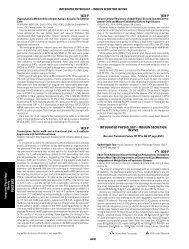Mechanisms for the Deterioration in Glucose Tolerance ... - Diabetes
Mechanisms for the Deterioration in Glucose Tolerance ... - Diabetes
Mechanisms for the Deterioration in Glucose Tolerance ... - Diabetes
You also want an ePaper? Increase the reach of your titles
YUMPU automatically turns print PDFs into web optimized ePapers that Google loves.
PROTEASE INHIBITOR–INDUCED GLUCOSE INTOLERANCE<br />
TABLE 7<br />
Basel<strong>in</strong>e systemic glucose and FFA turnover and clearance<br />
Be<strong>for</strong>e 12 weeks<br />
P vs.<br />
basel<strong>in</strong>e<br />
<strong>Glucose</strong> turnover (mol kg 1 m<strong>in</strong> 1 )<br />
NRTI pretreated 9.6 0.8 8.4 0.7<br />
NRTI naïve 11.8 0.4 9.2 1.0<br />
Both 10.3 0.5 8.7 0.6 0.002<br />
Normal volunteers 11.3 0.5<br />
P vs. groups<br />
<strong>Glucose</strong> turnover plasma <strong>in</strong>sul<strong>in</strong><br />
(mol kg<br />
0.08<br />
1 m<strong>in</strong> 1 pmol/l 1 )<br />
NRTI pretreated 1042 201 1073 175<br />
NRTI naïve 706 131 792 101<br />
Both 913 138 965 117 0.55<br />
Normal volunteers 826 143<br />
P vs. groups<br />
<strong>Glucose</strong> clearance (ml kg<br />
0.34<br />
1 m<strong>in</strong> 1 )<br />
NRTI pretreated 2.10 0.17 1.58 0.14<br />
NRTI naïve 2.44 0.13 1.61 0.16<br />
Both 2.21 0.13 1.59 0.10 0.001<br />
Normal volunteers 2.31 0.11<br />
P vs. groups<br />
FFA turnover<br />
0.93<br />
NRTI pretreated 2.68 0.25 4.80 0.42<br />
NRTI naïve 3.12 0.31 5.89 0.90<br />
Both 2.85 0.20 5.22 0.44 0.001<br />
Normal volunteers 3.54 0.3<br />
P vs. groups<br />
FFA clearance (ml kg<br />
0.15<br />
1 m<strong>in</strong> 1 )<br />
NRTI pretreated 4.79 0.66 8.16 0.79<br />
NRTI naïve 7.26 1.02 9.20 0.86<br />
Both 5.74 0.64 8.56 0.58 0.001<br />
Normal volunteers 7.90 0.94<br />
P vs. groups 0.06<br />
Data are means SD.<br />
consistent with <strong>the</strong> conclusion that <strong>in</strong>sul<strong>in</strong> clearance had<br />
been reduced. If C-peptide clearance been altered, one<br />
would expect to f<strong>in</strong>d a change <strong>in</strong> <strong>the</strong> plasma pro<strong>in</strong>sul<strong>in</strong>–<br />
to–plasma C-peptide ratio. The practical significance of<br />
this f<strong>in</strong>d<strong>in</strong>g is that changes <strong>in</strong> plasma <strong>in</strong>sul<strong>in</strong> concentrations<br />
cannot be used as an <strong>in</strong>dex of -cell function dur<strong>in</strong>g<br />
treatment with protease <strong>in</strong>hibitor–conta<strong>in</strong><strong>in</strong>g regimens.<br />
In conclusion, <strong>the</strong> present study <strong>in</strong>dicates that protease<br />
<strong>in</strong>hibitor–conta<strong>in</strong><strong>in</strong>g regimens impair glucose tolerance <strong>in</strong><br />
HIV-<strong>in</strong>fected patients by two mechanisms: 1) <strong>in</strong>ducement<br />
of peripheral <strong>in</strong>sul<strong>in</strong> resistance <strong>in</strong> skeletal muscle and<br />
adipose tissue and 2) reduction <strong>in</strong> pancreatic -cell function.<br />
There are several cl<strong>in</strong>ical implications of this study.<br />
First, use of <strong>the</strong>se regimens may cause deterioration of<br />
glycemic control <strong>in</strong> patients with preexist<strong>in</strong>g diabetes.<br />
Second, because <strong>the</strong>se regimens appear to <strong>in</strong>duce <strong>in</strong>sul<strong>in</strong><br />
resistance predom<strong>in</strong>antly <strong>in</strong> skeletal muscle and adipose<br />
tissue, antidiabetic agents that exert <strong>the</strong>ir major action on<br />
peripheral tissues ra<strong>the</strong>r than on <strong>the</strong> liver (e.g., thiazolid<strong>in</strong>ediones)<br />
would appear advantageous (48). Third, because<br />
first-phase <strong>in</strong>sul<strong>in</strong> release appears to be more severely<br />
impaired than second-phase <strong>in</strong>sul<strong>in</strong> release, secretagogues<br />
such as <strong>the</strong> meglit<strong>in</strong>ides, which primarily improve firstphase<br />
<strong>in</strong>sul<strong>in</strong> release (49), may be preferable to sulfonylureas,<br />
which apparently only affect second-phase <strong>in</strong>sul<strong>in</strong><br />
release (49).<br />
ACKNOWLEDGMENTS<br />
This work was supported <strong>in</strong> part by Division of Research<br />
Resources GCRC Grant 5MO1 RR 00044, <strong>the</strong> National<br />
Institute of <strong>Diabetes</strong> and Digestive and Kidney Diseases<br />
Grant DK-20411 (to J.E.G.), and NIAID grant AI 27658 (to<br />
R.C.R.).<br />
We thank Mary Little <strong>for</strong> her excellent editorial assistance<br />
and <strong>the</strong> nurs<strong>in</strong>g and laboratory staff of <strong>the</strong> General<br />
Cl<strong>in</strong>ical Research Center <strong>for</strong> <strong>the</strong>ir superb help.<br />
REFERENCES<br />
1. Flexner C: HIV-protease <strong>in</strong>hibitors. N Engl J Med 338:1281–1292, 1998<br />
2. Hruz P, Murata H, Mueckler M: Adverse metabolic consequences of HIV<br />
protease <strong>in</strong>hibitor <strong>the</strong>rapy: <strong>the</strong> search <strong>for</strong> a central mechanism. Am J<br />
Physiol Endocr<strong>in</strong>ol Metab 280:E549–E553, 2001<br />
3. Lee E, Walmsley S, Fantus I: New-onset diabetes mellitus associated with<br />
protease <strong>in</strong>hibitor <strong>the</strong>rapy <strong>in</strong> an HIV-positive patient: case report and<br />
review. CMAJ 161:161–164, 1999<br />
4. Visnegarwala F, Krause K, Musher D: Severe diabetes associated with<br />
protease <strong>in</strong>hibitor <strong>the</strong>rapy. Ann Intern Med 127:947, 1997<br />
5. Behrens G, Dejam A, Schmidt H, Balks H, Brabant G, Korner T, Stoll M,<br />
Schmidt R: Impaired glucose tolerance, beta cell function and lipid<br />
metabolism <strong>in</strong> HIV patients under treatment with protease <strong>in</strong>hibitors. AIDS<br />
13:F63–F70, 1999<br />
6. Tsiodras S, Mantzoros C, Hammer S, Samore M: Effects of protease<br />
<strong>in</strong>hibitors on hyperglycemia, hyperlipidemia, and lipodystrophy: a 5-year<br />
cohort study. Arch Intern Med 160:2050–2056, 2000<br />
7. Ja<strong>in</strong> R, Furf<strong>in</strong>e E, Pedneault L, White A, Lenhard J: Metabolic complica-<br />
924 DIABETES, VOL. 52, APRIL 2003
















